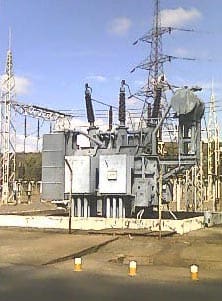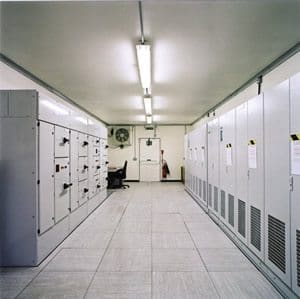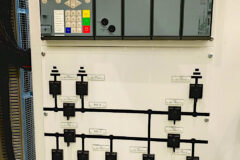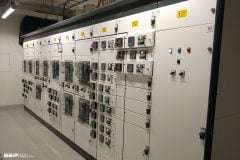
The construction of new substations and the expansion of existing facilities are common place projects in electric utilities. However, due to the complexity, very few utility employees are familiar with the complete process that allows these projects to be successfully completed. This article will attempt to highlight the major issues associated with these capital-intensive construction projects, and provide a basic understanding of the types of issues that must be addressed during this process.
There are four major types of electric substations.
The first type is the switchyard at a generating station. These facilities connect the generators to the utility grid and also provide off-site power to the plant. Generator switchyards tend to be large installations that are typically engineered and constructed by the power plant designers and are subject to planning, finance, and construction efforts different from those of routine substation projects. Because of their special nature, the creation of power plant switchyards will not be discussed here, but the expansion and modification of these facilities generally follow the routine processes.
Another type of substation is typically known as the customer substation. This type of substation functions as the main source of electric power supply for one particular business customer. The technical requirements and the business case for this type of facility depend highly on the customer’s requirements, more so than on utility needs, so this type of station will also not be the primary focus of this discussion.
The third type of substation involves the transfer of bulk power across the network and is referred to as a switching station. These large stations typically serve as the end points for transmission lines originating from generating switchyards, and they provide the electrical power for circuits that feed distribution stations. They are integral to the long-term reliability and integrity of the electric system and enable large blocks of energy to be moved from the generators to the load centers.

Since these switching stations are strategic facilities and usually very expensive to construct and maintain, these substations will be one of the major focuses of this chapter.
The fourth type of substation is the distribution substation. These are the most common facilities in electric power systems and provide the distribution circuits that directly supply most electric customers. They are typically located close to the load centers, meaning that they are usually located in or near the neighborhoods that they supply, and are the stations most likely to be encountered by the customers.
Since the construction of distribution stations creates the majority of projects in utility substation construction budgets, these facilities will be the other major focus of this article.
Needs Determination
An active planning process is necessary to develop the business case for creating a substation or making major modifications. Planners, operating and maintenance personnel, asset managers, and design engineers are among the various employees typically involved in considering such issues in substation design as load growth, system stability, system reliability, and system capacity, and their evaluations determine the need for new or improved substation facilities.
Customer requirements, such as a new factory, etc., should be considered as well as customer relations and complaints. In some instances, political factors also influence this process, such as when reliability is a major issue. At this stage, the elements of the surrounding area are defined and assessed, and a required in-service date is established.
The planning process produces a basic outline of what is required in what area.
Budgeting
Having established the broad requirements for the new station — such as voltages, capacity, number of feeders, etc. — the issue of funding must be addressed. This is typically when real estate investigations of available sites begin, since site size and location can significantly affect the cost of the facility. Preliminary equipment layouts and engineering evaluations are also undertaken at this stage in order to develop ballpark costs, which then have to be evaluated in the corporate budgetary justification system.
Preliminary manpower forecasts for all disciplines involved in the engineering and construction of the substation should be undertaken, including identification of the nature and extent of any work that the utility may need to contract out.
This budgeting process will involve evaluation of the project in light of corporate priorities and provide a general overview of cost and other resource requirements. Note that this process may be an annual occurrence. Any projects in which monies have yet to be spent are generally reevaluated during every budget cycle.
Financing

Once the time has arrived for work to proceed on the project, the process of obtaining funding for the project must be started. Preliminary detailed designs are required in order to develop firm pricing. Coordination between business units is necessary to develop accurate costs and to develop a realistic schedule. This may involve detailed manpower forecasting in many areas. The resource information has to be compiled in the format necessary to be submitted to the corporate capital estimate system, and internal presentations must be conducted to sell the project to all levels of management.
Sometimes it may be necessary to obtain funding to develop the capital estimate. This may be the case when the cost to develop the preliminary designs is beyond normal departmental budgets, or if unfamiliar technology is expected to be implemented. This can also occur on large, complex projects or when a major portion of the work will be contracted. It may also be necessary to obtain early partial funding in cases where expensive, long-lead-time equipment may need to be purchased, such as large power transformers.
Traditional and Innovative Substation Design
Traditionally, high-voltage substations are engineered based on established layouts and concepts and conservative requirements. This approach can restrict the degree of freedom in introducing new solutions.
System requirements include elements of rated voltage, rated frequency, system configuration present and future, connected loads, lines, generation, voltage tolerances (over and under), thermal limits, short-circuit levels, frequency tolerance (over and under), stability limits, critical fault clearing time, system expansion, and interconnection.
Customer requirements include environmental consideration (climatic, noise, aesthetic, spills, right-of-way), space consideration, power quality, reliability, availability, national and international applicable standards, network security, expandability, and maintainability. Carefully selected design criteria could be developed to reflect the company philosophy. This would enable consideration and incorporation of elements such as life-cycle cost, environmental impact, initial capital investment, etc. into the design process.
Design solutions could then be evaluated based on established evaluation criteria that satisfy the company interests and policies.











The Article is informative however as per title it shalll be more eloborative like the reason it is need, choice / selection of voltage levels and further type of substation as per construction point of view and lastly it should also clarified country wide / region wise trend.
Useful article as well as comments
I am doing a design in which i have a challenge in the design. the challenge goes like this. I have a mv-panel of 800A to supplied with 4Nos.1x4x150mm PVC/SWA/PVC cable at a distance of 45m. My problem is to fine the voltage drop. So you have to recognize 4Nos. 4core 150mm during your calculation.
The question is how one determined that 4 Nos. 4-C, 150sqmm would be required. Do you know the short circuit level? And why 4-C cables?
We have only one problem when we consider the siting of a new power station.
In the UK today, that problem is knowledge.
Today we have few engineers with experience of building either major generation plants, (over 2GB) and the T&D circuits and operation, that are required to use the power generated.
There is no useful knowledge to be found in the self opinionated UK media or the mainly engineering illiterate in the UK government, house of Commons and Lords.
The knowledge IS to be found, in the existing UK system, built from the 1950s through to the 1980’s. A programme of re-education is required for all engineers who are associated with the development of the future Generation, T&D of power in the UK so that they understand what our forebears had to learn and established.
The core guidance should be technical judgements based on security, availability and flexibility.
All these judgements have held us in good stead until the more recent energy policies from 2004, which have been written and devised by engineers working under the gaze of the technically ignorance, and politically inept.
Knowledge is the 1st step to determining where, watts and when new based load power stations should be built and we are already 10 years behind in the replacement programme of our once premier generation and , T&D circuits and control assets.
very informative article